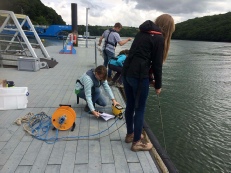

The salinity increased with depth at all of the time intervals (Figure 23b) because saline water is denser than freshwater, causing the more saline water to lie beneath the fresh river water. This is also applicable to temperature because temperature decreased with depth (Figure 23a) and colder water is denser than warmer water.
The salinity was highest at the start of the time series (Figure 23b) because high tide was at 0836 UTC so there was a large volume of seawater in the Fal when first measurements were taken. The tide ebbed throughout the times series, leading to a greater proportion of river water and a decrease in salinity. The temperature increased throughout the time series (Figure 23a) for a number of reasons including longer exposure to increased air temperature and solar irradiance, as well as an increasing proportion of warmer river water due to an ebbing tide.
Irradiance attenuates exponentially through the water column with depth, which is clearly seen from the pontoon time series results (Figure 22). This is due to the water scattering and absorbing light, which restricts production to the upper water column or euphotic zone. Attenuation differs between light wavelengths, with blue light attenuating further down the water column than red light. The only anomaly observed is the irradiance increasing unexpectedly between 3m and 4m during the 0935 UTC time interval. This is likely to be due either to human or instrumentation error.

Oxygen is a by-product of photosynthesis. The greatest DO levels are observed at the surface (Figure 24b) because that is where the greatest irradiance levels occur in that region, meaning that oxygen producing phytoplankton are likely to be most abundant in the surface. This should explain the increased DO at the surface, however the chlorophyll measurements show no correlation to this. This could be because the fluorometer had to be recalibrated several times when the chlorophyll concentrations were being measured and so the output was not consistent.
Direction of flow was southward for the majority of the time series (Figure 20) as a result of the ebbing tide. However, eastward flow was observed at the surface around 90 minutes into the time series. It uncertain what the cause of this anomaly is, but possible explanations include an increase in wind influence or the creation of an eddy. There was no significant boat traffic during the time.
Flow speed was observed to be slower at the surface and bottom of the water column (Figure 21) due to wind friction at the air-water interface and bottom friction at the seabed.



| Physics |
| Chemistry |
| Biology |
| Niskin |
| Flow meter |
| Light meter |
| Exosonde |
| Discussion |
| Physics |
| Chemistry |
| Biology |